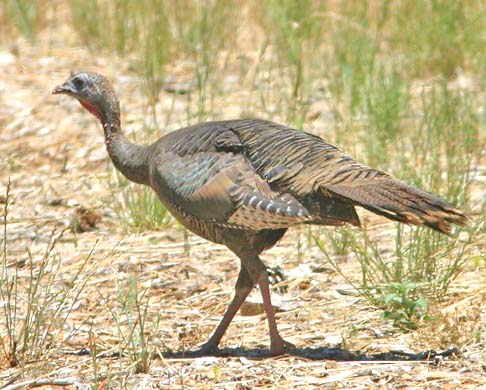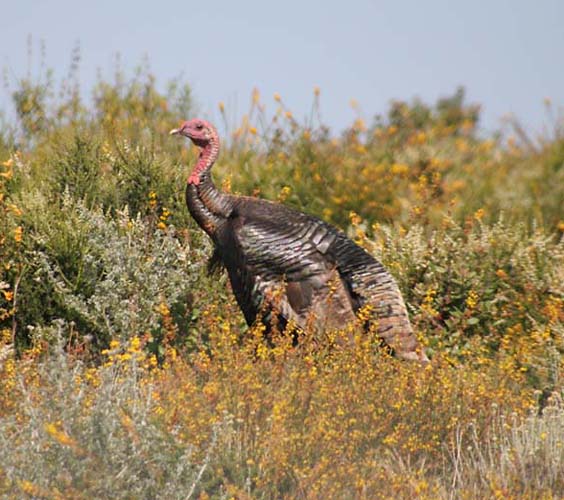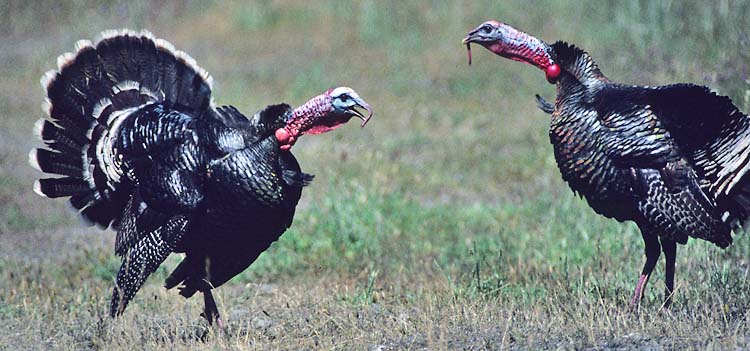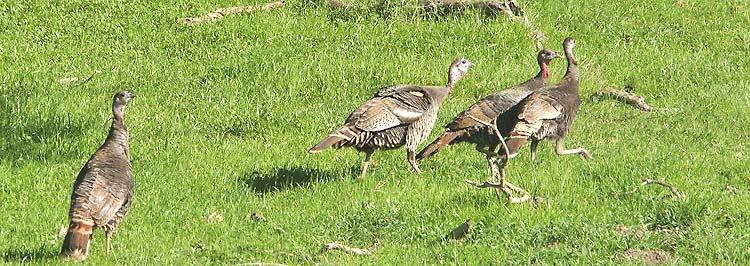| |
TURKEYS Meleagridinae
a subfamily of Pheasants & allies Phasianidae
|
- 2 species in North America
- DR personal total: 1 species (50%), 1 photo'd
|
 There are only two species of Turkeys extant in the world today; the Wild Turkey (left) of North America, and the Ocellated Turkey Meleagris ocellata
of the Yucatan Peninsula, Mexico. From the fossil record they were once
much more widespread and there were more species. Turkeys were
"distributed continuously from middle latitudes of North America to
northern South America during the Pleistocene" (Porter 1994). Today the
Wild Turkey exists as a native only in eastern and southwestern North
America and northernmost Mexico; populations on the West Coast and in
the Great Basin are introduced. However, since turkeys were once native
to some of these areas, it can be argued they are "re-introduced into a
former range" rather than being a despised non-native gamebird. The
evidence suggests that Wild Turkey was once native to northern
California but it was never native to southern California, were a
different and now-extinct species [Meleagris californica] once existed [see an essay on this topic]. There are only two species of Turkeys extant in the world today; the Wild Turkey (left) of North America, and the Ocellated Turkey Meleagris ocellata
of the Yucatan Peninsula, Mexico. From the fossil record they were once
much more widespread and there were more species. Turkeys were
"distributed continuously from middle latitudes of North America to
northern South America during the Pleistocene" (Porter 1994). Today the
Wild Turkey exists as a native only in eastern and southwestern North
America and northernmost Mexico; populations on the West Coast and in
the Great Basin are introduced. However, since turkeys were once native
to some of these areas, it can be argued they are "re-introduced into a
former range" rather than being a despised non-native gamebird. The
evidence suggests that Wild Turkey was once native to northern
California but it was never native to southern California, were a
different and now-extinct species [Meleagris californica] once existed [see an essay on this topic].
Males
have elaborate breeding displays (left). They attempt to impress by
gobbling, inflating neck wattles, drooping the wings, raising and
spreading the tail, and puffing out the chest so the sunlight catches
the iridescence. Males can be as focused on disputing each other
(below) as on a female. |
|
| Usually,
turkeys are shy and secretive, even where introduced, and will
high-step away once anyone gets to near. This harem (below) has spotted
me and are on the run. Both the native and introduced populations are
hunted. Indeed, turkeys were so important as a food source in early
American history that Benjamin Franklin proposed they become the United
States' national bird, an honor that was bestowed instead on the Bald
Eagle. |
|
 Young
birds (left) and females lack the elaborate wattles of males, but are
easily recognized as turkeys by the huge size and gangly shape. Because
they are so popular as a game bird, attempts to introduce turkeys (or
re-introduce if speaking on an epochal scale) to California started as
early as 1877. Various subspecies have been involved, but most have
been of the south Texas and northern Mexican subspecies M. g. intermedia
(Grinnell & Miller 1944). The birds shown on this page with whitish
to buffy-white tips to the rectrices are likely from that stock; those
with rusty tail tips may be ranch-raised stock from eastern populations
(M. g. silvestris or osceola). Many of the efforts to
introduce turkeys in California failed, such as on Santa Cruz Island or
in the far northwest in Humboldt Co., sometimes because the habitat was
inappropriate. Turkeys in California thrive best in extensive oak
woodlands with a heavy acorn crop. Young
birds (left) and females lack the elaborate wattles of males, but are
easily recognized as turkeys by the huge size and gangly shape. Because
they are so popular as a game bird, attempts to introduce turkeys (or
re-introduce if speaking on an epochal scale) to California started as
early as 1877. Various subspecies have been involved, but most have
been of the south Texas and northern Mexican subspecies M. g. intermedia
(Grinnell & Miller 1944). The birds shown on this page with whitish
to buffy-white tips to the rectrices are likely from that stock; those
with rusty tail tips may be ranch-raised stock from eastern populations
(M. g. silvestris or osceola). Many of the efforts to
introduce turkeys in California failed, such as on Santa Cruz Island or
in the far northwest in Humboldt Co., sometimes because the habitat was
inappropriate. Turkeys in California thrive best in extensive oak
woodlands with a heavy acorn crop. |
 In
my home of Monterey County, the turkeys originated from very aggressive
stocking operations by Calif. Fish & Game which began in 1965 and
continued for about a decade. At least 361 birds were released over the
past 30 years, some 277 of which were California ranch-raised birds or
wild trapped individuals from previously established populations in
nearby Santa Clara and San Benito counties. Birds were usually released
in groups of 8-14 to form stable flocks. From this start, good habitat
(oak woodland) and good climate produced bumper "wild-bred" crops of
youngsters and the population spread widely through the habitat. Our
atlas estimate was 500 pairs in Monterey County alone, but this was
likely low (Roberson & Tenney 1993). They are now widely
distributed, including on Fort Ord, where Steve Rovell got this lovely
shot (right). In
my home of Monterey County, the turkeys originated from very aggressive
stocking operations by Calif. Fish & Game which began in 1965 and
continued for about a decade. At least 361 birds were released over the
past 30 years, some 277 of which were California ranch-raised birds or
wild trapped individuals from previously established populations in
nearby Santa Clara and San Benito counties. Birds were usually released
in groups of 8-14 to form stable flocks. From this start, good habitat
(oak woodland) and good climate produced bumper "wild-bred" crops of
youngsters and the population spread widely through the habitat. Our
atlas estimate was 500 pairs in Monterey County alone, but this was
likely low (Roberson & Tenney 1993). They are now widely
distributed, including on Fort Ord, where Steve Rovell got this lovely
shot (right).
|
 Turkeys were traditionally placed in their own family, the Meleagrididae, including by the Handbook of the Birds of the World
series (Porter 1994). However, molecular evidence shows that turkeys,
along with grouse, are lineages embedded within the larger
pheasant/partridge assemblage (e.g., Dimcheff et al. 2002). Turkeys were traditionally placed in their own family, the Meleagrididae, including by the Handbook of the Birds of the World
series (Porter 1994). However, molecular evidence shows that turkeys,
along with grouse, are lineages embedded within the larger
pheasant/partridge assemblage (e.g., Dimcheff et al. 2002).
The
AOU (1998) and Dickinson (2003) now consider turkeys and grouse to be
subfamilies of Phasianidae. In prior versions of my family list I had
followed HBW in retaining each group as a 'traditional' family — each
of which is easily recognized and each of which is a monophyletic group
— but now the weight of the evidence is strong enough to compel the
merger of turkeys and grouse into the Phasianidae. I retain this
separate page, though, for convenience. |
Photos: all photos of Wild Turkey Meleagris gallopavo
were taken in California. The top top photos and the last shot were
from Lake County on 17 May 1998; the remainder are from Monterey
County. The running harem was in upper Carmel Valley on 17 Mar 2007;
the young bird was a Jamesburg on 11 June 2005, and Steve Rovell
photographed the Ft. Ord male on 25 May 2005. Photo © D. Roberson, except the photograph © Steve Rovell and used with permission; all rights reserved.
Bibliographic note:
There is no "family book" per se, although the literature on the Wild
Turkey is vast. An good introduction to the subfamily is in Porter
(1994).
Literature cited:
American Ornithologists' Union. 1998. Check-list of North American Birds. 7th ed. A.O.U., Washington, D. C.
Dickinson,
E., ed. 2003. The Howard & Moore Complete Checklist of the Birds of
the World. 3d ed. Princeton Univ. Press, Princeton, N.J.
Dimcheff,
D.E., S.V. Drovetski, and D.P. Midnell. 2002. Phylogeny of Tetraoninae
and other galliform birds using mitochondrial 12s and ND2 genes.
Molecular Phylogenetics & Evolution 24: 203-215.
Grinnell, J., and A.H. Miller. 1944. Distribution of the Birds of California. Pac. Coast Avifauna 27. Cooper Ornith. Society.
Porter, W.F. 1994. Family Meleagrididae (Turkeys) in del Hoyo, J., Elliott, A., & Sargatal, J., eds. Handbook of the Birds of the World. Vol. 2. Lynx Edicions, Barcelona.
Roberson, D., and C. Tenney, eds. 1993. Atlas of Breeding Birds of Monterey County. Monterey Pen. Audubon Soc., Carmel, CA.
|
|
|



 Young
birds (left) and females lack the elaborate wattles of males, but are
easily recognized as turkeys by the huge size and gangly shape. Because
they are so popular as a game bird, attempts to introduce turkeys (or
re-introduce if speaking on an epochal scale) to California started as
early as 1877. Various subspecies have been involved, but most have
been of the south Texas and northern Mexican subspecies M. g. intermedia
(Grinnell & Miller 1944). The birds shown on this page with whitish
to buffy-white tips to the rectrices are likely from that stock; those
with rusty tail tips may be ranch-raised stock from eastern populations
(M. g. silvestris or osceola). Many of the efforts to
introduce turkeys in California failed, such as on Santa Cruz Island or
in the far northwest in Humboldt Co., sometimes because the habitat was
inappropriate. Turkeys in California thrive best in extensive oak
woodlands with a heavy acorn crop.
Young
birds (left) and females lack the elaborate wattles of males, but are
easily recognized as turkeys by the huge size and gangly shape. Because
they are so popular as a game bird, attempts to introduce turkeys (or
re-introduce if speaking on an epochal scale) to California started as
early as 1877. Various subspecies have been involved, but most have
been of the south Texas and northern Mexican subspecies M. g. intermedia
(Grinnell & Miller 1944). The birds shown on this page with whitish
to buffy-white tips to the rectrices are likely from that stock; those
with rusty tail tips may be ranch-raised stock from eastern populations
(M. g. silvestris or osceola). Many of the efforts to
introduce turkeys in California failed, such as on Santa Cruz Island or
in the far northwest in Humboldt Co., sometimes because the habitat was
inappropriate. Turkeys in California thrive best in extensive oak
woodlands with a heavy acorn crop. There are only two species of Turkeys extant in the world today; the Wild Turkey (left) of North America, and the Ocellated Turkey Meleagris ocellata
of the Yucatan Peninsula, Mexico. From the fossil record they were once
much more widespread and there were more species. Turkeys were
"distributed continuously from middle latitudes of North America to
northern South America during the Pleistocene" (Porter 1994). Today the
Wild Turkey exists as a native only in eastern and southwestern North
America and northernmost Mexico; populations on the West Coast and in
the Great Basin are introduced. However, since turkeys were once native
to some of these areas, it can be argued they are "re-introduced into a
former range" rather than being a despised non-native gamebird. The
evidence suggests that Wild Turkey was once native to northern
California but it was never native to southern California, were a
different and now-extinct species [Meleagris californica] once existed [see
There are only two species of Turkeys extant in the world today; the Wild Turkey (left) of North America, and the Ocellated Turkey Meleagris ocellata
of the Yucatan Peninsula, Mexico. From the fossil record they were once
much more widespread and there were more species. Turkeys were
"distributed continuously from middle latitudes of North America to
northern South America during the Pleistocene" (Porter 1994). Today the
Wild Turkey exists as a native only in eastern and southwestern North
America and northernmost Mexico; populations on the West Coast and in
the Great Basin are introduced. However, since turkeys were once native
to some of these areas, it can be argued they are "re-introduced into a
former range" rather than being a despised non-native gamebird. The
evidence suggests that Wild Turkey was once native to northern
California but it was never native to southern California, were a
different and now-extinct species [Meleagris californica] once existed [see  In
my home of Monterey County, the turkeys originated from very aggressive
stocking operations by Calif. Fish & Game which began in 1965 and
continued for about a decade. At least 361 birds were released over the
past 30 years, some 277 of which were California ranch-raised birds or
wild trapped individuals from previously established populations in
nearby Santa Clara and San Benito counties. Birds were usually released
in groups of 8-14 to form stable flocks. From this start, good habitat
(oak woodland) and good climate produced bumper "wild-bred" crops of
youngsters and the population spread widely through the habitat. Our
atlas estimate was 500 pairs in Monterey County alone, but this was
likely low (Roberson & Tenney 1993). They are now widely
distributed, including on Fort Ord, where Steve Rovell got this lovely
shot (right).
In
my home of Monterey County, the turkeys originated from very aggressive
stocking operations by Calif. Fish & Game which began in 1965 and
continued for about a decade. At least 361 birds were released over the
past 30 years, some 277 of which were California ranch-raised birds or
wild trapped individuals from previously established populations in
nearby Santa Clara and San Benito counties. Birds were usually released
in groups of 8-14 to form stable flocks. From this start, good habitat
(oak woodland) and good climate produced bumper "wild-bred" crops of
youngsters and the population spread widely through the habitat. Our
atlas estimate was 500 pairs in Monterey County alone, but this was
likely low (Roberson & Tenney 1993). They are now widely
distributed, including on Fort Ord, where Steve Rovell got this lovely
shot (right).  Turkeys were traditionally placed in their own family, the Meleagrididae, including by the Handbook of the Birds of the World
series (Porter 1994). However, molecular evidence shows that turkeys,
along with grouse, are lineages embedded within the larger
pheasant/partridge assemblage (e.g., Dimcheff et al. 2002).
Turkeys were traditionally placed in their own family, the Meleagrididae, including by the Handbook of the Birds of the World
series (Porter 1994). However, molecular evidence shows that turkeys,
along with grouse, are lineages embedded within the larger
pheasant/partridge assemblage (e.g., Dimcheff et al. 2002).